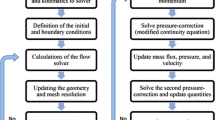Abstract
Fish are able to make good use of vortices. In a complex flow field, many fish continue to maintain both efficient cruising and maneuverability. Traditional man-made propulsion systems perform poorly in complex flow fields. With fish-like propulsion systems, it is important to pay more attention to complex flow fields. In this paper, the influence of vortices on the hydrodynamic performance of 2-D flapping-foils was investigated. The flapping-foil heaved and pitched under the influence of inflow vortices generated by an oscillating D-section cylinder. A numerical simulation was run based the finite volume method, using the computational fluid dynamics (CFD) software FLUENT with Reynolds-averaged Navier-Stokes (RANS) equations applied. In addition, dynamic mesh technology and post processing systems were also fully used. The calculations showed four modes of interaction. The hydrodynamic performance of flapping-foils was analyzed and the results compared with experimental data. This validated the numerical simulation, confirming that flapping-foils can increase efficiency by absorbing energy from inflow vortices.
Similar content being viewed by others
References
Anderson JM (1996). Vorticity control for efficiency propulsion. Massachusetts Institutes of Technology, Cambridge, 47–180.
Beal DN (2003). Propulsion through wake synchronization using flapping-foil. PhD, thesis, Massachusetts Institutes of Technology, Cambridge, 76–84.
Bearman PW (1984). Vortex shedding from oscillating bluff bodies. Annual Review of Fluid Mechanics, 16, 195–222.
Gopalkrishnan R, Triantafyllou MS, Triantafyllou GS (1994). Active vorticity control in a shear flow using a flapping foil. Journal of Fluid Mechanics, 27(4), 1–21.
Guglielmini L, Blondeaux P (2004). Propulsive efficiency of oscillating foils. European Journal of Mechanics B/Fluids, 23, 255–278.
Liao Q, Dong GJ, Lu XY (2004). Vortex formation and force characteristic of a foil in the wake of a circular cylinder. Journal of Fluids and Structures, 19, 491–510.
Sarpkaya T (1979). Vortex-induced oscillations, a selective review. Journal of Applied Mechanics, 46, 241–258.
Simmons JEL (1974). Phase-angle measurements between hot-wire signals in the turbulent wake of a two-dimensional bluff body. Journal of Fluid Mechanics, 64, 599–609.
Song HJ, Wang Z, Yin XZ (2004). Numerical simulation on unsteady motion of 2D airfoil. Journal of Hydrodynamics, 19(A)Supplement, 896–903.
Stansby PK (1976). The locking-on of vortex shedding due to the cross-stream vibration of circular cylinders in uniform and shear flows. Journal of Fluid Mechanics, 74, 641–665.
Streitlien K, Triantafyllou GS (1996).Efficient foil propulsion through vortex control. AIAA Journal, 34(11), 2315–2318.
Triantafyllou MS, Triantafyllou GS, Yue DKP (2000). Hydrodynamics of fishlike swimming. Fluid Mech, 32, 33–53.
Wang FJ (2004). The Analysis of computational fluid dynamics-The theory and application of CFD software. Tsinghua University Press, Beijing, 120–126.
Wang J (2000). Vortex shedding and frequency selection in flapping flight. J. Fluid Mech, 410, 323–341.
Williamson CHK, Roshko A (1988). Vortex formation in the wake of an oscillating cylinder. Journal of Fluids and Structures, 2, 355–381.
Yang L, Su YM (2007). Hydrodynamic analysis of an oscillating tail-fin in viscous flows. Journal of Harbin Engineering University, 28(10), 1073–1078.
Author information
Authors and Affiliations
Corresponding author
Additional information
Foundation item: Supported by the National Natural Science Foundation of China under Grant No. 50579007, 50879014 and the specialized research fund for the doctoral program of higher education under Grant No. 200802170010.
Xi Zhang was born in 1985. He received the bachelor degree in Shipbuilding and Marine Engineering at Harbin Engineering University. His current research interests include CFD and bionic engineering.
Yu-min Su was born in 1960. He is a professor at the School of Shipbuilding Engineering, Harbin Engineering University. His current research interests include fluid dynamics and marine propeller design, system integration of underwater vehicles
Liang Yang was born in 1980. He received his Ph.D degree from Harbin Engineering University. His current research interests include CFD of ship and bionic engineering.
Zhao-li Wang was born in 1983. He received M.Sc in Design and Construction of Naval Architecture and Ocean Structure in 2008. Now he is working for the Ph.D degree in Engineering Mechanics at Harbin Engineering University.
Rights and permissions
About this article
Cite this article
Zhang, X., Su, Ym., Yang, L. et al. Hydrodynamic performance of flapping-foil propulsion in the influence of vortices. J. Marine. Sci. Appl. 9, 213–219 (2010). https://doi.org/10.1007/s11804-010-9074-0
Received:
Published:
Issue Date:
DOI: https://doi.org/10.1007/s11804-010-9074-0




